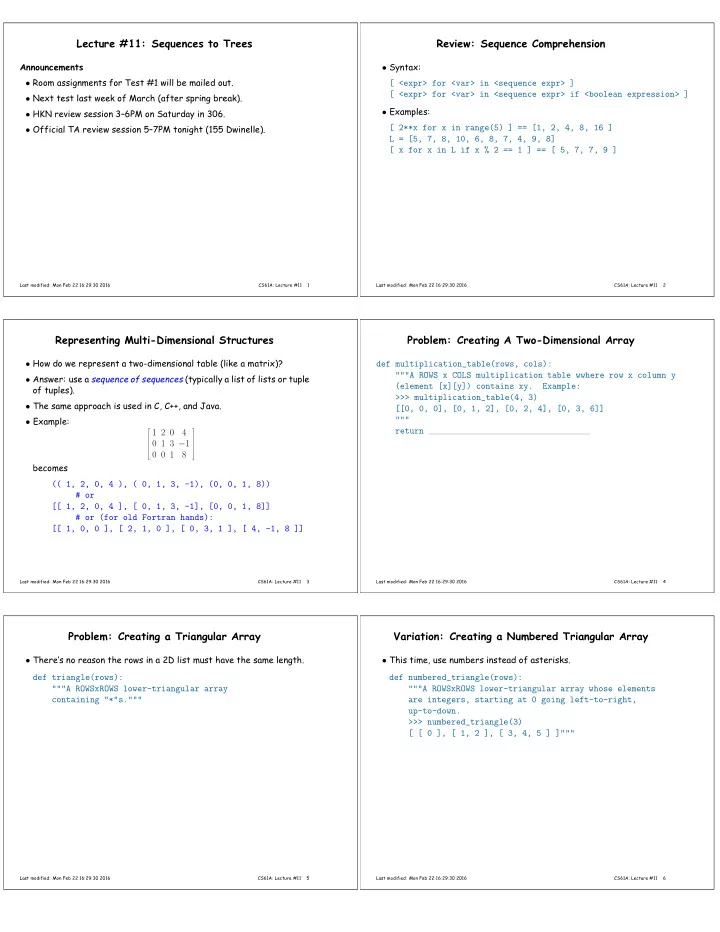

Lecture #11: Sequences to Trees Review: Sequence Comprehension Announcements • Syntax: • Room assignments for Test #1 will be mailed out. [ <expr> for <var> in <sequence expr> ] [ <expr> for <var> in <sequence expr> if <boolean expression> ] • Next test last week of March (after spring break). • Examples: • HKN review session 3–6PM on Saturday in 306. [ 2**x for x in range(5) ] == [1, 2, 4, 8, 16 ] • Official TA review session 5–7PM tonight (155 Dwinelle). L = [5, 7, 8, 10, 6, 8, 7, 4, 9, 8] [ x for x in L if x % 2 == 1 ] == [ 5, 7, 7, 9 ] Last modified: Mon Feb 22 16:29:30 2016 CS61A: Lecture #11 1 Last modified: Mon Feb 22 16:29:30 2016 CS61A: Lecture #11 2 Representing Multi-Dimensional Structures Problem: Creating A Two-Dimensional Array • How do we represent a two-dimensional table (like a matrix)? def multiplication_table(rows, cols): """A ROWS x COLS multiplication table wwhere row x column y • Answer: use a sequence of sequences (typically a list of lists or tuple (element [x][y]) contains xy. Example: of tuples). >>> multiplication_table(4, 3) • The same approach is used in C, C++, and Java. [[0, 0, 0], [0, 1, 2], [0, 2, 4], [0, 3, 6]] """ • Example: return 1 2 0 4 0 1 3 − 1 0 0 1 8 becomes (( 1, 2, 0, 4 ), ( 0, 1, 3, -1), (0, 0, 1, 8)) # or [[ 1, 2, 0, 4 ], [ 0, 1, 3, -1], [0, 0, 1, 8]] # or (for old Fortran hands): [[ 1, 0, 0 ], [ 2, 1, 0 ], [ 0, 3, 1 ], [ 4, -1, 8 ]] Last modified: Mon Feb 22 16:29:30 2016 CS61A: Lecture #11 3 Last modified: Mon Feb 22 16:29:30 2016 CS61A: Lecture #11 4 Problem: Creating a Triangular Array Variation: Creating a Numbered Triangular Array • There’s no reason the rows in a 2D list must have the same length. • This time, use numbers instead of asterisks. def triangle(rows): def numbered_triangle(rows): """A ROWSxROWS lower-triangular array """A ROWSxROWS lower-triangular array whose elements containing "*"s.""" are integers, starting at 0 going left-to-right, up-to-down. >>> numbered_triangle(3) [ [ 0 ], [ 1, 2 ], [ 3, 4, 5 ] ]""" Last modified: Mon Feb 22 16:29:30 2016 CS61A: Lecture #11 5 Last modified: Mon Feb 22 16:29:30 2016 CS61A: Lecture #11 6
And Why Stop There? Trees Trees With Labels • We can have rows of rows, and rows of rows of rows, but we needn’t • Generally, there can be data at each node, called labels : stop at an arbitrary limit. 20 • Result what is a form of tree : • 15 10 • 10 8 9 • 1 9 2 5 • How can we represent this structure? 3 7 8 • The dots and numbers are generally called vertices or nodes , con- nected by edges . • Top node is the root , bottom ones are leaves , others are inner nodes . • Each node is itself the root of a subtree ; those immediately below are its children . Last modified: Mon Feb 22 16:29:30 2016 CS61A: Lecture #11 7 Last modified: Mon Feb 22 16:29:30 2016 CS61A: Lecture #11 8 Tree Interface Tree Representation • Evidently, trees have labels and children, suggesting an API like this: def make_tree(label, kids = []) """A (sub)tree with given LABEL at its root, whose children def make_tree(label, kids = []) are KIDS.""" """A (sub)tree with given LABEL at its root, whose children return [ label ] + kids are KIDS.""" def label(tree): def label(tree): """The label on TREE.""" """The label on TREE.""" return tree[0] def children(tree): def children(tree): """The immediate descendants of TREE (each a tree).""" """The immediate descendants of TREE (each a tree).""" return tree[1:] def isleaf(tree): """True if TREE is a leaf node.""" def isleaf(tree): """True if TREE is a leaf node.""" return len(tree) == 1 • Representation? Alternatives? Last modified: Mon Feb 22 16:29:30 2016 CS61A: Lecture #11 9 Last modified: Mon Feb 22 16:29:30 2016 CS61A: Lecture #11 10 Tree Representation (II) Algorithms on Trees • Trees have a recursive structure. A tree is: def make_tree(label, kids = []) """A (sub)tree with given LABEL at its root, whose children – A label and are KIDS.""" – Zero or more children, each a tree. return (label, kids) • Recursive structure implies recursive algorithm. def label(tree): """The label on TREE.""" return tree[0] def children(tree): """The immediate descendants of TREE (each a tree).""" return tree[1] def isleaf(tree): """True if TREE is a leaf node.""" return len(children(tree)) == 0 Last modified: Mon Feb 22 16:29:30 2016 CS61A: Lecture #11 11 Last modified: Mon Feb 22 16:29:30 2016 CS61A: Lecture #11 12
Counting Leaves def count_leaves(tree): """The number of leaf nodes in TREE.""" Last modified: Mon Feb 22 16:29:30 2016 CS61A: Lecture #11 13
Recommend
More recommend